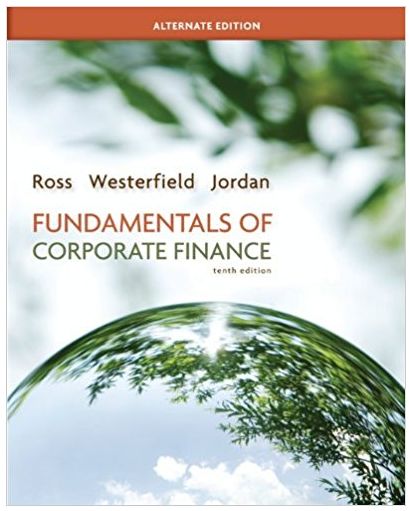This is a comprehensive project evaluation problem bringing together much of what you have learned in this
Question:
This is a comprehensive project evaluation problem bringing together much of what you have learned in this and previous chapters.
Suppose you have been hired as a financial consultant to Defense Electronics, Inc.
(DEI), a large, publicly traded firm that is the market share leader in radar detection systems (RDSs). The company is looking at setting up a manufacturing plant overseas to produce a new line of RDSs. This will be a five-year project. The company bought some land three years ago for $4.5 million in anticipation of using it as a toxic dump site for waste chemicals, but it built a piping system to safely discard the chemicals instead. The land was appraised last week for $5.3 million. In five years, the after tax value of the land will be $5.7 million, but the company expects to keep the land for a future project. The company wants to build its new manufacturing plant on this land; the plant and equipment will cost $32 million to build. The following market data on DEI's securities are current:
Debt: 230,000 7.2 percent coupon bonds outstanding, 25 years to maturity, selling for 108 percent of par; the bonds have a
$1,000 par value each and make semiannual payments.
Common stock: 8,800,000 shares outstanding, selling for $71 per share; the beta is 1.1.
Preferred stock: 450,000 shares of 5 percent preferred stock outstanding, selling for $81 per share.
Market: 7 percent expected market risk premium; 5 percent risk-free rate.
DEI uses G.M. Wharton as its lead underwriter. Wharton charges DEI spreads of 8 percent on new common stock issues, 6 percent on new preferred stock issues, and 4 percent on new debt issues. Wharton has included all direct and indirect issuance costs (along with its profit) in setting these spreads. Wharton has recommended to DEI that it raise the funds needed to build the plant by issuing new shares of common stock. DEI's tax rate is 35 percent. The project requires $1,300,000 in initial net working capital investment to get operational. Assume Wharton raises all equity for new projects externally.
a. Calculate the project's initial Time 0 cash flow, taking into account all side effects.
b. The new RDS project is somewhat riskier than a typical project for DEI, primarily because the plant is being located overseas. Management has told you to use an adjustment factor of 12 percent to account for this increased riskiness.
Calculate the appropriate discount rate to use when evaluating DEI's project.
c. The manufacturing plant has an eight-year tax life, and DEI uses straight-line depreciation. At the end of the project (that is, the end of Year 5), the plant and equipment can be scrapped for $4.5 million. What is the after tax salvage value of this plant and equipment?
d. The company will incur $6,800,000 in annual fixed costs. The plan is to manufacture 17,000 RDSs per year and sell them at $10,800 per machine; the variable production costs are $9,400 per RDS. What is the annual operating cash flow (OCF) from this project?
e. DEI's comptroller is primarily interested in the impact of DEI's investments on the bottom line of reported accounting statements. What will you tell her is the accounting break-even quantity of RDSs sold for this project?
f. Finally, DEI's president wants you to throw all your calculations, assumptions, and everything else into the report for the chief financial officer; all he wants to know is what the RDS project's internal rate of return (IRR) and net present value (NPV) are. What will you report?
Common StockCommon stock is an equity component that represents the worth of stock owned by the shareholders of the company. The common stock represents the par value of the shares outstanding at a balance sheet date. Public companies can trade their stocks on... Net Present Value
What is NPV? The net present value is an important tool for capital budgeting decision to assess that an investment in a project is worthwhile or not? The net present value of a project is calculated before taking up the investment decision at... Internal Rate of Return
Internal Rate of Return of IRR is a capital budgeting tool that is used to assess the viability of an investment opportunity. IRR is the true rate of return that a project is capable of generating. It is a metric that tells you about the investment... Salvage Value
Salvage value is the estimated book value of an asset after depreciation is complete, based on what a company expects to receive in exchange for the asset at the end of its useful life. As such, an asset’s estimated salvage value is an important... Coupon
A coupon or coupon payment is the annual interest rate paid on a bond, expressed as a percentage of the face value and paid from issue date until maturity. Coupons are usually referred to in terms of the coupon rate (the sum of coupons paid in a... Discount Rate
Depending upon the context, the discount rate has two different definitions and usages. First, the discount rate refers to the interest rate charged to the commercial banks and other financial institutions for the loans they take from the Federal... Par Value
Par value is the face value of a bond. Par value is important for a bond or fixed-income instrument because it determines its maturity value as well as the dollar value of coupon payments. The market price of a bond may be above or below par,...
Step by Step Answer:

Fundamentals of corporate finance
ISBN: 978-0078034633
10th edition
Authors: Stephen Ross, Randolph Westerfield, Bradford Jordan





